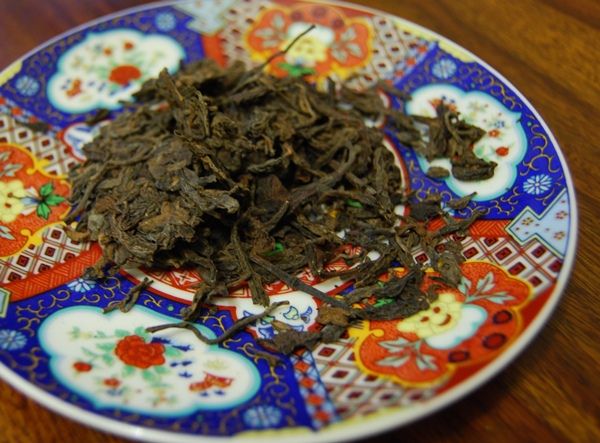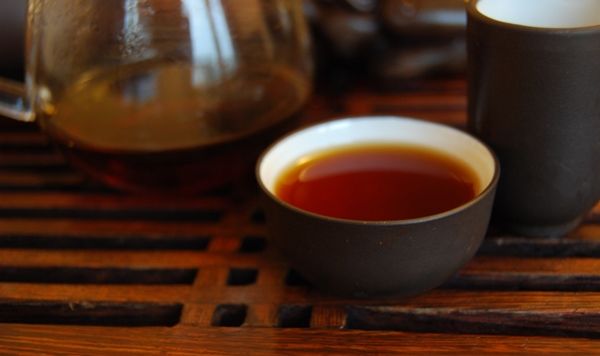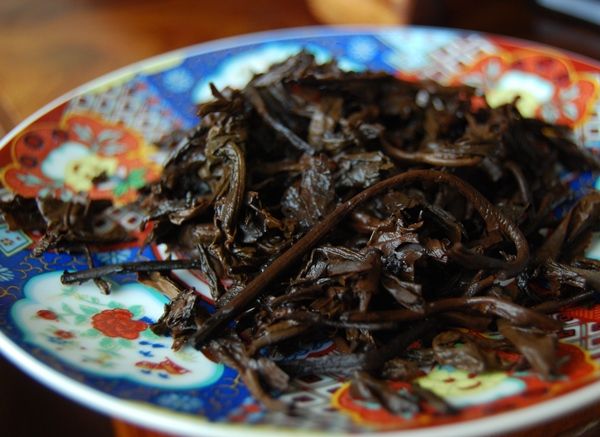I have had a torrid time when it comes to 8582, the classical recipe from the Mighty Menghai. My recent cakes, admittedly, are great. The aged samples of 8582 that I have encountered, are not. Or, rather, to commit the cardinal sin of quoting myself, from a 1998 version, "This is a very pleasant tea. It is crisp, smooth, and sweet. However, it is distinctly impotent."
Maximum overkudos, then, to the generosity of BH, who sent me the package above to put me out of my misery.
Learning from past tea sessions, I set this tea aside until I could give it the proper amount of time and concentration. In this instance, it was a Saturday morning when the Zhonglish ladies (Lei & Chinese Mama) took Xiaohu out to the shops for a few hours. You know you're getting old when you get the house to yourself and you drink tea.
Unlike the disconcertingly green 8582 "aged" recipes from Tearoma, these leaves show us how it should be done: they are heavy, rusty orange.
Hallowed be thy soup: this is thick, red, and has the reassuring aroma of heavy, oaken scents. It is impossible not to fall in love with this tea: the body is lightly vibrant, heavily viscous, and yet it still retains the tangy edge of its youth. The storage has been first class.
Wisps of vanilla remain in the nose, alongside a decent huigan and a solid cooling sensation on the roof of the mouth. This tea is very much alive, and its years have been kind to it. Remarkably, there is all manner of nuance and subtlety in its character, which are present alongside its heavy burden of leaf content.
It brews many brews without loss of complexity, and gives me amply counterevidence in favour of this old recipe. Thanks to BH for the most triumphant tea session.
See also: a retaste here.





Good North-American evening, Mr Hobbes!
ReplyDeleteI am a long-time reader of your blog. Despite having little experience with Puercha, I find your writings to be a thoroughly enjoyable read. I tend towards the enjoyment of Japanese green teas (Sencha, Gyokuro, etc) rather than black teas.
I am very interested in getting a start in Puercha. I have one cake that a friend have me. It is a 2008, but I cannot identify it further due to the non-English label, rather than the label "Da Yi Xiang." To me, it tastes rather "fishy." Can you suggest a somewhat inexpensive, accessible puer from tearoma that might be a good place to start?
Thank you!
Celeborn
Ah yes, you have yet another North American reader chiming in. I've also been reading your blog for the past several months. First of all, I'd like to say thanks. It was reading your blog that encouraged me to take the plunge into the puerh world. Since that time, I've purchased around 7 cakes and I'm buying more monthly (in fact, I may make a purchase this week if I can convince the wife.)
ReplyDeleteI had a general question. I've been purchasing most of my puerh from puerhshop, and the owner graciously included a sample of their 1998 dry stored cnnp 7542.
My question is this: should the color of the liquor be about the same as yours in the above photographs? I know a tea will age more or less quickly given the environment of its storage, but my tea is nowhere near as dark. For certain, it has some reddening in the color which is mostly noticeable at the top of the cup, but the color is a light to medium orange. It is not the dark orange/red shown in your photographs.
It makes me wonder if it's really from 1998. Regardless, the sample I've been drinking has been fabulous and complex. Earthy, Floral, sweet, a hint of sourness, and some bitterness left over from its youth. It has a great huigan that seems to carry on even into late infusions and a noticeable chaqui. I might have to purchase a cake just thinking about it!
Thanks for your blog. I might have to make my own someday and perhaps we can share thoughts and you can help guide this newbie along.
As the english like to say, Toodlepip, and all of that jazz.
-Blake.
Hi, chaps!
ReplyDeleteApologies for the delay in responding, but I've been in China where all Google-based blogs (inc. Blogspot / Blogger) are blocked by the Great Firewall.
Celeborn - Tearoma teas have proven to be fairly, dare I say it, unreliable, based on my past experience. I'm not sure that I would recommend any of them with any particular enthusiasm, although there was a 2001 Xiaguan cake that, even though turned out to be a fake, was good pu'ercha. It was clean and sharp - very nicely aged. At the price, it's good tea.
For other introductions, I would recommend the likes of Essence of Tea (all of their home-made cakes, for example), Yunnan Sourcing (ditto), Red Lantern, and China Chadao. The Changtai and Douji products sold by the last two are reliable introductions.
Blake - I look forward to seeing your blog! Tea-writing tends to get a little light on the Internet, and we need new writers to step up!
I would expect a 1998 cake to be dark. That said, if it were really, really dry in its storage (perhaps Kunming or Beijing), then it could stay more orange. How was the character? Has it deepened into woodiness?
Toodlepip,
Hobbes
Howdy Hobbes, Blake Again.
ReplyDeleteI did notice some 'earthiness'. Can't say I tasted anything that reminded me of wood outright. Perhaps what I was tasting was indeed 'woody' but yours and my terminology could be different.
Considering I've never had another sample nearing that age, I don't quite know what I should've expected. The color of the liquor did surprise me. Once again, it was definitely lighter than your example. Light orange with a tiny bit of red at the top of the cup. Either way, it was good tea.
I might think twice about shelling out the cash for something advertised as a 98 that isn't though.
I just might have to plunge into the blogging world. This little convo could be the push I need.
Thanks,
-Blake